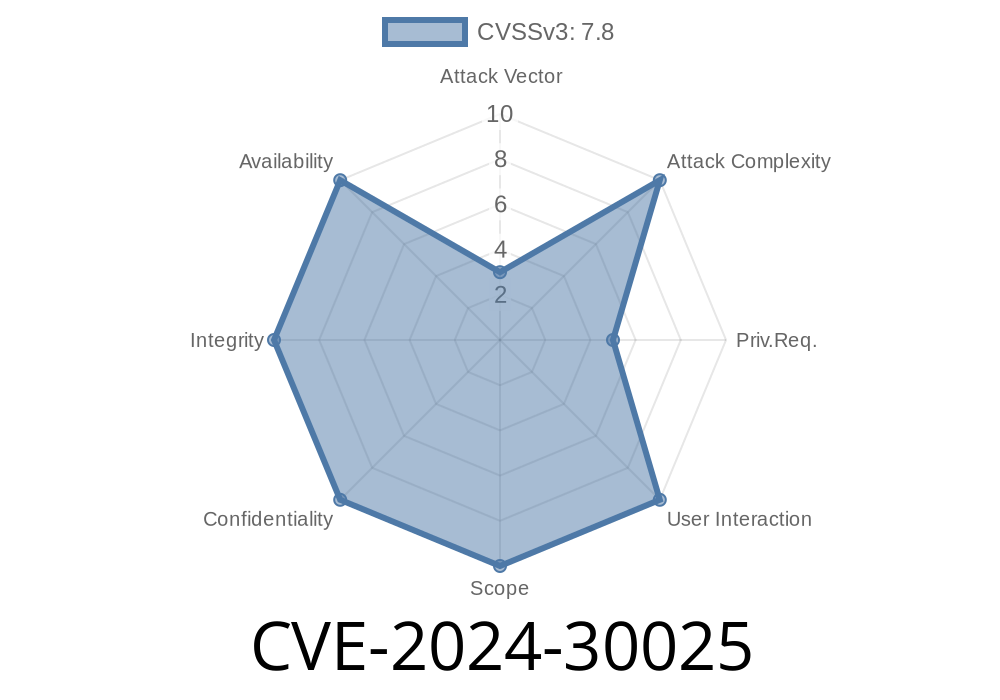---
Published: June 2024
Author: [Your Name / Lab]
Category: Windows Security, Vulnerability Analysis
Introduction: What is CVE-2024-30025?
In May 2024, Microsoft patched a serious vulnerability tracked as CVE-2024-30025 in the Windows Common Log File System (CLFS) driver. If you haven’t heard of CLFS before, it’s a kernel driver that helps Windows handle log files used by the system and many applications.
This vulnerability allows a local attacker (someone who can run code on your computer) to gain SYSTEM privileges—the highest access possible on Windows. In plain talk: If a hacker gets into your user account, they could use this flaw to take over the entire system.
This article breaks down what CVE-2024-30025 is, why it matters, and how attackers are exploiting it, with actual code snippets and links for further reading.
CVE-2024-30025 is rated High with a CVSS base score around 7.8/10. What makes it scary is that
- No user interaction or special permissions are needed beyond basic code execution (any regular user).
Where Is the Flaw?
The bug exists in the way the CLFS.sys driver (located at C:\Windows\System32\drivers\clfs.sys) handles specially-crafted log files. When the driver parses log records, it fails to properly validate some user-controllable values, leading to out-of-bounds memory writes or, in some cases, memory corruption.
What’s the Impact?
By crafting a malicious log file and convincing the system to process it, an attacker can overwrite sensitive kernel memory (like security tokens), leading to privilege escalation.
Example Exploit Code Snippet (For Research ONLY)
> Warning: NEVER run untrusted code on your own machine. The following is a simplified conceptual example.
> Full exploits are publicly available, such as those referenced at github.com.
// Pseudo-exploit: CLFS log file creation (simplified version)
HANDLE hFile = CreateFileW(L"exploit.clfs", GENERIC_READ | GENERIC_WRITE,
, NULL, CREATE_ALWAYS, FILE_ATTRIBUTE_NORMAL, NULL);
if (hFile != INVALID_HANDLE_VALUE) {
// Construct malicious log file header and contents
BYTE logRecord[1024];
memset(logRecord, x41, sizeof(logRecord)); // fill with 'A's for PoC
// Overwrite offset with carefully-calculated value
*(DWORD*)(logRecord + OFFSET) = MALICIOUS_VALUE;
DWORD bytesWritten = ;
WriteFile(hFile, logRecord, sizeof(logRecord), &bytesWritten, NULL);
CloseHandle(hFile);
}
// Use Windows API to ask CLFS to process the malicious log
// This may require specific CLFS API calls or a third-party trigger
GitHub Proof-of-Concept:
https://github.com/Wh04m1001/CVE-2024-30025
Binary Exploit & Writeup:
https://lolcathost.github.io/blog/2024/Windows-CLFS-EoP/
https://www.zerodayinitiative.com/blog/2024/5/14/the-quest-for-clfs-day/
Malware Authors: Weaponized for ransomware or persistent backdoors.
- Targeted Attacks: Espionage groups use this to jump from user to system level on sensitive networks.
Apply Microsoft Updates Immediately:
See Microsoft Security Update Guide and run Windows Update now.
Summary
CVE-2024-30025 is a critical bug in a core Windows system driver that attackers can use for local privilege escalation. Exploiting it is pretty straightforward if anyone gets code execution on your system. Patch your Windows devices as soon as possible.
References & Further Reading
- Microsoft Security Advisory - CVE-2024-30025
- ZDI Exploit Write-up
- GitHub PoC
- LOLCatHost Detailed Blog
Timeline
Published on: 05/14/2024 17:16:58 UTC
Last modified on: 06/19/2024 20:58:39 UTC
